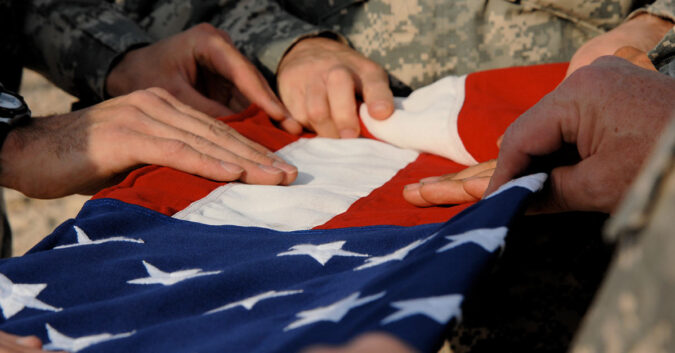May 29th marks the 53rd official Memorial Day since Congress designated the last Monday of May a national observance in 1971.
Memorial Day is woven into the fabric of U.S. history. Memorialization and decoration services date as far back as 1868, during the American Civil War.
The importance of Memorial Day cannot be overlooked. Amidst parades, backyard barbecues, and time with loved ones, it’s also especially important for Americans to reflect on the sacrifices millions of soldiers have made to uphold the freedoms and liberties that define America.
Since the dawn of the Revolutionary War, more than 1.2 million American soldiers of all different backgrounds have given their lives in service to our country and its ideals.
This Memorial Day, we pause to honor and remember these brave men and women in uniform, support their families and loved ones, and vow to pay their sacrifices forward.
Protecting and Serving Fallen Soldiers and Veterans Is Our Duty
It takes a truly special and selfless individual to join the military and put their life on the line to protect their fellow citizens. In the course of U.S. history, millions of brave Americans have answered this call.
It’s important to not only remember the sacrifices made by these individual soldiers, but to step up and support soldiers when they leave active duty and return to civilian life. Each year, around 200,000 American soldiers retire from service and become veterans.
Unfortunately, many of these veterans face an often overwhelming amount of difficulties upon leaving the military.
Around 33% of veterans suffer from mental health issues like depression, anxiety, and post-traumatic stress disorder (PTSD), and 53% of veterans experience chronic physical health issues from their time in the military, according to the U.S. Department of Veterans Affairs (VA).
Physical service-related health conditions can include:
- Brain and head trauma from injuries sustained during military service
- Diseases caused by exposure to carcinogenic substances like arsenic and asbestos
- Illnesses from the toxic water at Camp Lejeune
- Long-term health problems caused by military burn pits
- Tinnitus and hearing loss due to exposure to loud explosions/noises
- Wounds caused by shrapnel or gunshots
Each year, the VA Central Cancer Registry records around 50,000 new cases of cancer among U.S. veterans. Compared to the general U.S. population, veterans are 20-40% more likely to be diagnosed with cancer, according to the National Cancer Institute.
Mesothelioma — a rare and aggressive cancer caused by exposure to asbestos — and illnesses linked to the water at Camp Lejeune are two such examples of how these diseases disproportionately impact veterans.
At Sokolove Law, we proudly support veterans and their families by getting them the help they need following a service-related illness. Contact us today to learn more about legal options and health care resources for veterans.
Help for Veterans with Mesothelioma
Approximately 33% of all mesothelioma cases involve U.S. veterans. For much of the 20th century, nearly every U.S. Navy ship contained asbestos in some capacity, which put veterans of the U.S. Navy at a particularly high risk of developing mesothelioma.
Sokolove Law has VA-accredited mesothelioma attorneys who can help eligible veterans and their loved ones pursue financial compensation from every avenue available to them.
Mesothelioma compensation options may include:
- Claims with asbestos trust funds set up by bankrupt companies
- Settlements or verdicts from mesothelioma lawsuits
- VA benefits, including health care, disability compensation, and pensions
At Sokolove Law, we fight to maximize the amount of money veterans with mesothelioma are able to receive from legal claims.
Call (800) 995-1212 now to learn more about your mesothelioma legal options.
Toxic Water Exposure at Camp Lejeune
Veterans and their family members who were stationed at U.S. Marine Corps Base Camp Lejeune in North Carolina for a minimum of 30 days between August 1, 1953 and December 31, 1987 may have developed serious illnesses from exposure to contaminated water on base.
Thanks to the Camp Lejeune Justice Act of 2022, veterans diagnosed with service-related health issues now have until August 2024 to file a Camp Lejeune lawsuit.
Camp Lejeune water contamination health conditions may include:
- Aplastic anemia
- Birth defects
- Bladder cancer
- Breast cancer
- Cardiac defects
- Cervical cancer
- Colorectal cancer
- Esophageal cancer
- Heart attack
- Hepatic steatosis
- Infertility
- Kidney cancer
- Liver cancer
- Lung cancer
- Multiple myeloma
- Multiple sclerosis
- Myelodysplastic syndromes
- Non-Hodgkin’s lymphoma
- Pancreatic cancer
- Parkinson’s disease
- Prostate cancer
- Rectal cancer
- Sarcoma
- Scleroderma
Filing a Camp Lejeune lawsuit does not impact your existing VA benefits in any way. Veterans and their families can continue to receive their current VA benefits in addition to the financial compensation they may receive from a Camp Lejeune settlement.
Family members may also be able to file a Camp Lejeune wrongful death lawsuit on behalf of loved ones who may have died as a result of an illness linked to the contaminated water at Camp Lejeune.
Sokolove Law Is Committed to Supporting Veterans
On special occasions like Memorial Day, it’s important for all U.S. citizens to take time to reflect on the freedoms we hold dear.
For the vast majority of Americans who are not soldiers or veterans, simply expressing gratitude for the sacrifices soldiers make when they sign up for duty is one small gesture that can have a major impact.
For more than 40 years, Sokolove Law has proudly supported veterans in getting the help they need after being diagnosed with service-related illnesses like mesothelioma and lung cancer.
To date, we’ve secured over $9.3 Billion for our clients nationwide.
If you are a veteran who developed an illness you believe to be a result of your service in the U.S. Armed Forces, we strongly encourage you to reach out to us today.
We are here to listen to your story and help you explore all of the options available to you. Get started today with a free case review.
